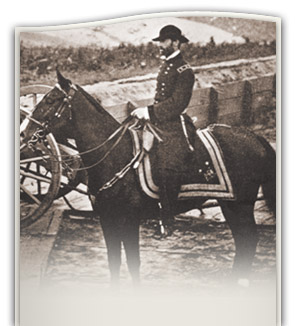
![]() tlanta is a city defined by its strong culture, its diverse community, and its rich history. It’s the birthplace of renowned civil rights leader Martin Luther King, Jr.; the home of the 1996 Olympic Games; and the base of five professional sports teams. The city also boasts the world’s largest aquarium, the Fox Theatre, the CNN Center, and the Coca-Cola Company. [QUICK FACTS about Atlanta]
tlanta is a city defined by its strong culture, its diverse community, and its rich history. It’s the birthplace of renowned civil rights leader Martin Luther King, Jr.; the home of the 1996 Olympic Games; and the base of five professional sports teams. The city also boasts the world’s largest aquarium, the Fox Theatre, the CNN Center, and the Coca-Cola Company. [QUICK FACTS about Atlanta]
Literally From the Ashes

Union General William T. Sherman, Atlanta, Georgia, 1864
The city arose from a humble beginning. In fact, before the name “Atlanta” was suggested in 1845, one of the names it went by was simply “Terminus,” so called because of the railroad station located near the present-day Georgia World Congress Center, the site of the present General Conference session.
In the early nineteenth century, before the land was taken over by White settlers (in 1822), present-day Atlanta belonged to the Creek and Cherokee Native American tribes. Once White settlers took over the land, the area was essentially depopulated. But by 1860, the population had increased from 30 residents to more than 9,500. However, during the American Civil War in 1864, residents evacuated the area and Atlanta was captured and burned to the ground (except for churches and hospitals) by Union general William T. Sherman. The city demonstrated resilience, beginning its way to recovery just one week later as civilians returned and started the gradual rebuilding process.
Atlanta made a full recovery from this event, with almost 5 million people living in the metropolitan area by 2006, according to a census report. Atlanta claims the world’s busiest airport, the Hartsfield-Jackson Atlanta International Airport, into which the majority of delegates and guests flew to attend the session. The city is also one of the most congested in the United States. But with the Metropolitan Atlanta Rapid Transit Authority (MARTA) (the city’s bus and subway system), three major highways uniting within its borders (Interstates 20, 85, and 75), and an extensive network of other freeways, Atlanta has become a top transportation hub. “The Connector,” the point where I-75 and I-85 meet, is one of the ten most clogged segments of interstate highways in the United States.
Seventh-day Adventists in Atlanta
The Adventist Church experienced a slow start in Atlanta. C. O. Taylor was the first Adventist worker to enter Georgia, in 1876. A decade later, a tent effort was held in the Atlanta area, and C. H. Bliss reported: “The meetings are quite well attended. . . . Some have already embraced the truth here, and we hope for others.”1 In that same report, Bliss also expresses his desire to see a church organized in Atlanta. This desire would not be realized until some years later. Charles F. Curtis and George W. Anglebarger moved to Atlanta in 1886 to look after the Adventist work, and Curtis took charge of the city mission, which was later closed because of a depression.
The Review and Herald, founded by James White in 1849, opened a branch office in Atlanta in 1889. It functioned for 12 years until the Southern Publishing Association was formed in Tennessee in 1901.
Melvin C. Sturdevant began the work among Blacks in Atlanta. “There is an abundance of work to be done in this place,” Sturdevant reported in 1900, “and we are encouraged.” When W. H. Sebastian joined Sturdevant seven years later to further the work, Sebastian was surprised to see that Blacks in the city seemed to be groping around in darkness, without a building of their own to worship in. House-to-house work was moving too slowly for the amount of people that Adventist workers wanted to reach—some 65,000 Blacks.2 Sturdevant, Sebastian, and other workers did not give up, however, and their work and diligence paid off. In 1922 the General Conference (GC) voted to build a church for the Black membership in Atlanta. Because of the dedication of Adventist ministers and workers such as C. O. Taylor, C. H. Bliss, M. C. Sturdevant, and W. H. Sebastian, today there are more than 10 Adventist churches in the city of Atlanta, not including the Greater Atlanta area.
We’re Glad You’ve All Come
The General Conference decided to have the 2010 world session in Atlanta, partly because of its cultural diversity. Some 35,000 Seventh-day Adventists—session delegates, members, and guests from all around the world—are expected to be in attendance, a number that probably will double during the two weekends of the session. Years from now, Adventists and those outside the church will be reading reports about how the 2010 GC world session left a spiritual mark on Atlanta, on the United States, and on the world. This spiritual experience will become another landmark in Atlanta’s history.
 While you are in our great city, please enjoy some of the attractions that Atlanta has to offer—among them, the following:
While you are in our great city, please enjoy some of the attractions that Atlanta has to offer—among them, the following:
__________
__________
R. Steven Norman III is communication director of the Southern Union Conference of Seventh-day Adventists, with headquarters in Decatur, Georgia; and editor of Southern Tidings.